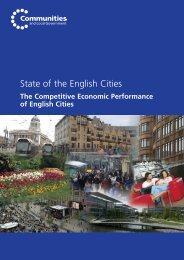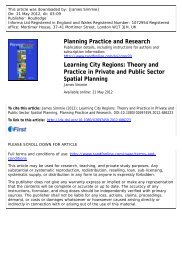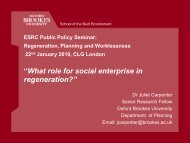History Matters: Path dependence and innovation in British city ...
History Matters: Path dependence and innovation in British city ...
History Matters: Path dependence and innovation in British city ...
Create successful ePaper yourself
Turn your PDF publications into a flip-book with our unique Google optimized e-Paper software.
These two studies illustrate how quite different<br />
evolutionary paths can arise between urban<br />
economies. In large part, these paths reflect<br />
how local conditions <strong>and</strong> constra<strong>in</strong>ts <strong>in</strong>herited<br />
from earlier economic development can<br />
shape the scope <strong>and</strong> opportunities for future<br />
development – not <strong>in</strong> any determ<strong>in</strong>istic way,<br />
but as a result of locally specific cont<strong>in</strong>gent<br />
conditions. To be sure, there are certa<strong>in</strong> generic<br />
economic processes <strong>and</strong> mechanisms that come<br />
<strong>in</strong>to play once activated by favourable local<br />
circumstances <strong>and</strong> conditions, but it is the<br />
locally cont<strong>in</strong>gent nature of the latter that is<br />
of critical importance, <strong>and</strong> this is where path<br />
<strong>dependence</strong> takes on a locally dependent<br />
nature (Mart<strong>in</strong> <strong>and</strong> Sunley, 2006). This makes<br />
the issue of policy somewhat problematic.<br />
4.4 Policy lessons<br />
The broad policy lessons that we take from<br />
this analysis are that it is necessary to th<strong>in</strong>k<br />
large-scale <strong>and</strong> long-term as opposed to<br />
small-scale <strong>and</strong> short-term. Those were the<br />
only k<strong>in</strong>ds of policy that we found that had a<br />
measurable impact either on <strong>in</strong>dividual firms<br />
or the aggregate figures for <strong>city</strong> economies.<br />
Furthermore, it is essential to build serious<br />
policy analysis <strong>in</strong>to proposals from the start<br />
<strong>in</strong> order to ascerta<strong>in</strong> what outcomes they<br />
generate on the ground.<br />
In look<strong>in</strong>g for possible policy lessons we adopt<br />
an explicitly evolutionary economic approach.<br />
This leads us to look for examples of public<br />
policy contributions to such phenomena as:<br />
• <strong>Path</strong> break<strong>in</strong>g non-equilibrium long-term<br />
change.<br />
• Internal (endogenous) sources of economic<br />
growth.<br />
• Market opportunities.<br />
• The co-evolution of non-economic factors<br />
with economic change.<br />
• The emergence <strong>and</strong> adaptation of <strong><strong>in</strong>novation</strong><br />
ecologies through time.<br />
Our first <strong>in</strong>sight was that, particularly<br />
<strong>in</strong> lead<strong>in</strong>g areas like Cambridge, there is<br />
widespread scepticism among private sector<br />
firms about the relevance or efficacy of public<br />
policy on <strong><strong>in</strong>novation</strong>. When asked to name<br />
any policy that had made a positive <strong>and</strong><br />
measurable difference to their <strong><strong>in</strong>novation</strong><br />
activities few could do so. Their development<br />
was largely based on the identification of<br />
market opportunities <strong>and</strong> organis<strong>in</strong>g to<br />
meet those dem<strong>and</strong>s. In lagg<strong>in</strong>g cities like<br />
Swansea, although few firms could identify<br />
any national or local public policies that<br />
had made a significant difference to their<br />
<strong><strong>in</strong>novation</strong> performance, they all recognised<br />
the significance of the large-scale European<br />
Union cohesion funds. Few of the firms we<br />
<strong>in</strong>terviewed <strong>in</strong> Swansea would have existed at<br />
all without the EU structural funds obta<strong>in</strong>ed as<br />
a result of the area’s Objective 1 <strong>and</strong> transition<br />
fund status. Some will undoubtedly cease<br />
to exist when the transition funds run out <strong>in</strong><br />
2013.<br />
Second, <strong>in</strong> contrast with the m<strong>in</strong>imal impact<br />
of public policies targeted specifically at local<br />
<strong><strong>in</strong>novation</strong>, several firms noted significant<br />
effects aris<strong>in</strong>g from other k<strong>in</strong>ds of policy.<br />
There was, for example, some criticism of<br />
local l<strong>and</strong> use plann<strong>in</strong>g as be<strong>in</strong>g too slow,<br />
bureaucratic <strong>and</strong> unimag<strong>in</strong>ative <strong>in</strong> the plann<strong>in</strong>g<br />
of transport <strong>and</strong> communications <strong>in</strong>frastructure<br />
<strong>and</strong> <strong>in</strong> restrictions placed on the physical<br />
development of the new knowledge-based<br />
economy. On the other h<strong>and</strong>, the large-scale<br />
town expansion schemes at both Northampton<br />
<strong>and</strong> Warr<strong>in</strong>gton proved to be very successful<br />
at generat<strong>in</strong>g <strong><strong>in</strong>novation</strong>s <strong>and</strong> creat<strong>in</strong>g new<br />
<strong>in</strong>dustrial pathways. Thus, while the plans were<br />
developed <strong>in</strong> the late 1960s <strong>and</strong> early 1970s,<br />
they have taken several decades for their<br />
current characteristics to evolve <strong>and</strong> emerge<br />
(Source: Universities’ own records).<br />
Third, it is also important to note that the<br />
promotion of <strong><strong>in</strong>novation</strong> <strong>in</strong> itself has not been<br />
one of the objectives of these town expansion<br />
schemes. Much of what they have achieved,<br />
however, has been based on the creation of<br />
an <strong>in</strong>novative set of <strong>in</strong>stitutional <strong>and</strong> cultural<br />
phenomena that positively encourage new<br />
economic growth <strong>and</strong> along with this, almost<br />
un<strong>in</strong>tentionally, <strong><strong>in</strong>novation</strong>. These f<strong>in</strong>d<strong>in</strong>gs<br />
po<strong>in</strong>t to the need for public policy to establish<br />
or encourage the co-evolution of <strong>in</strong>stitutional,<br />
cultural <strong>and</strong> economic change <strong>in</strong> local<br />
development trajectories. What is needed is<br />
a plann<strong>in</strong>g system dedicated to change <strong>and</strong><br />
expansion, an entrepreneurial culture <strong>and</strong> a<br />
search for market opportunities. This needs to<br />
be comb<strong>in</strong>ed with a well-educated workforce.<br />
Fourth, the town expansion schemes <strong>in</strong> our<br />
sample cities also illustrate the need for<br />
large-scale policies comb<strong>in</strong>ed with broad<br />
enabl<strong>in</strong>g objectives <strong>and</strong> the acceptance of<br />
considerable system redundancy, or the<br />
66













